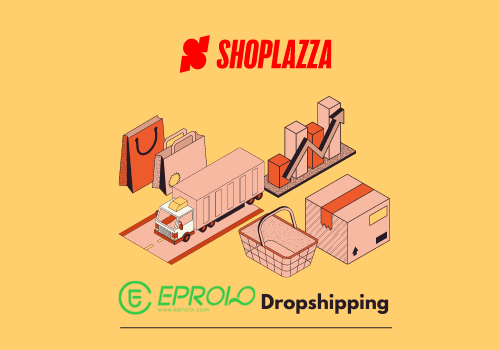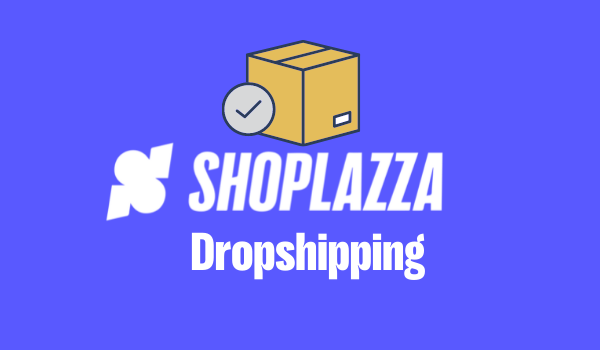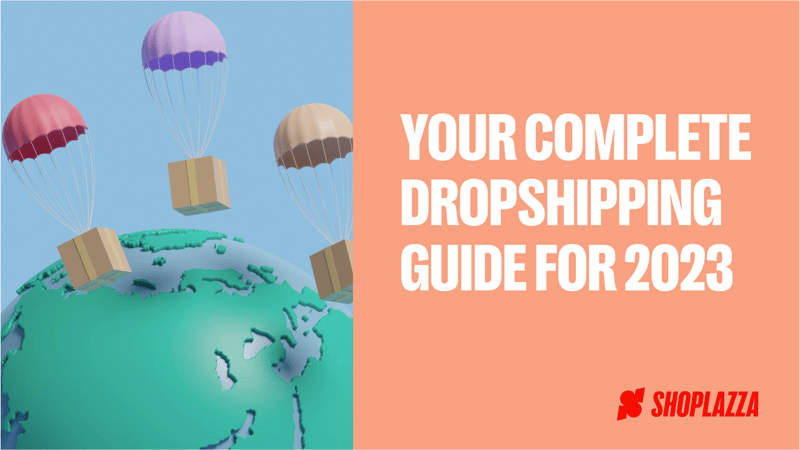
How does dropshipping work? We’ve put together a comprehensive dropshipping guide to show how easily you can build your own dropshipping business right now with Shoplazza.
Starting an online business can be challenging, especially for first-time entrepreneurs.
It’s not uncommon to get a bit overwhelmed with all the demands on your to-do list: Picking out a business model, deciding on an ecommerce website builder, sketching out a logo and branding strategy to build your brand image, clearing up space in the garage to store the products you’re going to sell online, doing the math to figure out the shipping setup…
And, of course, there’s also the part where you create your own website, launch it and hope those sales start coming in. It’s a lot to handle―with the added pressure of having to sell the products you already invested your money in.
There is, however, an easier and less risky way to open an ecommerce business: starting a dropshipping business with Shoplazza. In this guide to dropshipping, you’ll find everything you need to know about the topic and learn how to dropship with our help. Ready?
Dropshipping guide: table of contents
- What is dropshipping?
- Why start a dropshipping business?
- Why dropship with Shoplazza?
- How to dropship with Shoplazza
- How to market a dropshipping business
- Build a successful dropshipping business with Shoplazza
👉🏾 A tip from Shoplazza’s dropshipping guide
Shoplazza is one of the best platforms for entrepreneurs that want to build their own ecommerce business. Check us out:
What is dropshipping?
The dropshipping business model has been around for some years now, and it has rightfully earned its place as a great solution for entrepreneurs like you, looking to launch their online store.
What sets dropshipping apart from traditional business models is the fact that it involves less investments upfront, both in product sourcing and inventory. The best part is that dropshipping can be easily configured inside an ecommerce store, which means it’s possible to start selling almost as soon as you create your own store.
The dropshipping model is, in short, a business model where entrepreneurs sell products online, but don’t actually hold inventory of those products.
This means that, instead of acquiring hundreds of items upfront and then risking the possibility of not selling, you work with a dedicated dropshipping supplier who’ll be in charge of sourcing and manufacturing your product.
The supplier is also the one who will be holding your inventory, which is a crucial aspect of any dropshipping business. This means that, whenever a customer orders from your store, all you have to do is forward that order to the supplier, and they’ll fulfill it and ship right to your customers.
The dropshipping business model, explained
Before tackling how to dropship, it’s worth delving a little bit more into the explanation we’ve just given you.
A lot of the criticism dropshipping usually gets is centered around the idea that it’s just another scheme to make money online, or that it’s hard to build a reputable store because you’ll just be selling products made by a supplier you don’t even know. There are also critics who have a hard time grappling with the idea of dropshipping as a business model, saying that you’re basically just acting as a “middleman” between the end customer and the supplier.
The truth, however, is a bit different.
Dropshipping is a legitimate business model for any ecommerce store, and it should be understood as the framework that will guide your operations. An affiliate business is entirely different from a subscription business―and the same could be said when comparing an online store that offers freemium services to an ecommerce store that sells digital products.
These four business models work with different strategies for sourcing, manufacturing, shipping and advertising. And dropshipping is just another item on that business model list.
We shouldn’t refer to a dropshipping store as the “middleman” because it’s not a model to resell products that were bought from a bigger store. It’s merely a fulfillment solution available for entrepreneurs who:
- Do not have the space and/or materials to manufacture their own products
- Do not wish to risk losing money with inventory before getting their business idea off the ground
Shoplazza’s dropshipping guide: An x-ray of dropshipping attributions
Another thing that needs to be properly addressed are the responsibilities shared between the business owner and the supplier―not least because this is also a point most people struggle with when reading about how to open a dropshipping business.
As we mentioned above, dropshipping is not a “scheme” but rather a legitimate business model. And while it does involve working with a supplier, it doesn’t mean that the supplier takes center stage in the operation.
How to dropship: Who’s in charge of what
|
Store owner (you) |
Dropshipping supplier |
|
Managing the online store and brand presence online |
Inventory management and product manufacturing |
|
Advertising campaigns and marketing strategies |
Fulfilling orders |
|
Customer and after-sales service |
Shipping to customers |
Why start a dropshipping business?
One of the great advantages of starting a dropshipping business is that it demands a smaller upfront investment when compared to other, more traditional, ecommerce business models. After all, you won’t have to spend money on inventory and fulfillment, two aspects that usually drain a business owner’s budget.
However, building an online store centered around dropshipping also has a couple of other benefits.
- It’s easy to start: All you have to do is pick a product, create your very own online store and start selling. You don’t need to factor in the time it’ll take to order boxes upon boxes of products, much less the time you’ll spend setting up your inventory and figuring out best shipping practices.
- It’s scalable: Because your products are stored with dropshipping suppliers, scaling your online business revolves around business decisions that can be quickly implemented. After all, it’s easier to expand your product offering, for instance, if all it takes is selecting new products from your supplier and putting them up on the website. For a traditional ecommerce business, scaling means ordering new products, figuring out where to stock them and finding new packaging―a process that costs time and money.
- You can sell locally or globaly: With a dropshipping business, selling everywhere is a reality. Big dropshipping channels like AliExpress offer competitive shipping methods such as ePacket to deliver goods worldwide at pretty reasonable deadlines.
- More control over profit: While you’ll pay wholesale price for products when acquiring them with the supplier, dropshipping allows you to sell those items for the price you deem best. This means that you can better manage your profit margin and your business’ financial health as a whole.
It’s also worth mentioning that having a dropshipping store allows you to work with a global product sourcing approach, which means adding more diversity to your product catalog. By working with multiple dropshipping suppliers located all over the world, you can unlock unique offerings and manage a more exclusive catalog that will likely charm your customers.
👉🏿 A tip from Shoplazza’s dropshipping guide
Still not sure whether a dropshipping business is the way to go? Get answers to your questions below:
Why dropship with Shoplazza?
Before we move on to the actionable steps of this dropshipping guide (namely, how to dropship), we want to mention briefly that choosing an ecommerce platform is an important decision for any online business.
And when it comes to opening a dropshipping business, Shoplazza is one of the best solutions out there.
When you sign up, you gain access to our robust admin tools to help you manage every single aspect of your dropshipping store. And the best part is, you get a free-trial period to create your store and start selling―after all, we want you to really experience everything Shoplazza has to offer.
Shoplazza also has specific tools and resources made especially for entrepreneurs who want to start a dropshipping business, such as:
- Dedicated apps for everything dropshipping: Our App Store boasts a wide assortment of apps to help your dropshipping business take off. You can count on apps to trademark your logo, like Haloo, or comprehensive dropshipping solutions like Buttonify and CJDropshipping―which let you easily import products from marketplaces like AliExpress.
- Tools to help you sell on Amazon: Entrepreneurs who want to expand their business options and also sell on big marketplaces like Amazon can rely on different apps to help divert traffic to their Amazon stores. This is a great solution for people who aren’t 100% sure about opening a standalone dropshipping store and prefer to work with different income streams.
Lastly, there are also a couple of aspects that set Shoplazza apart from other ecommerce platforms out there, like the fact that we offer our merchants a lower break-even point to help businesses reach their own profitability marks at their own pace. Our platform was also built with SEO in mind, which means you can edit your wesite’s SEO directly on the admin before ever going live.
👉🏽 A tip from Shoplazza’s dropshipping guide
Check out the video below for more info on how to dropship and succeed here in Shoplazza:
How to dropship with Shoplazza
Now it’s time to cover the more practical aspects of our dropshipping guide, namely how to build a dropshipping business with Shoplazza.
The first thing you need to do is create a Shoplazza account. After that, you’ll be automatically redirected to the Shoplazza admin:
The admin is where most of your work as a dropshipping store owner will take place. That’s where you’ll connect with dropshipping apps, import products to the store, create product pages, tweak product descriptions and process payments with the help of providers like Payoneer, Klarna and dLocal.
1. What you need to do before opening a dropshipping store
Before setting up shop and working on specifics, like a store domain and social media handles, you need to find the best dropshipping products to sell on your online store.
Another aspect that makes dropshipping such a sustainable business model for up-and-coming entrepreneurs is the fact that it’s also pretty versatile when it comes to what you can sell. This means that you can explore niches and product ideas like:
- Pet supplies: Consider items like novelty beds, toys, clothes and even grooming items for dogs and cats. Or maybe bird cages and aquariums for those who prefer to keep fish as company.
- Electronics: Keyboards, wireless phones, gamer chairs and other accessories for streamers.
- Garment niche: T-shirts, dresses, swimwear, streetwear, shoes, pajamas, formalwear, costumes and anything in between.
- Stationery: Notebooks, journals (and journaling material), post-it notes, pads, pens and even stickers.
- Crafts: Selling crafts online is a niche that’s been consistently growing, and you can even establish a dropshipping store to provide the raw materials for artisans that are busy creating their own works.
- Jewelry: Rings, necklaces, anklets, earrings, piercings, wristwatches, fine jewelry and even body jewelry are all good dropshipping products that drive customer purchases.
- Home decor: Everything from pillows to plant pots, mugs, wall art, bathroom rugs and beyond.
👉🏿 A tip from Shoplazza’s dropshipping guide
Deciding on a product to sell is crucial for any online business interested on how to dropship. Check out the video below for more information on this topic:
2. Connect with a dropshipping app
After deciding what to sell, it’s time to connect your store with a dropshipping app and start searching for dropshipping suppliers.
You can do that by going to Apps on the right-hand menu of the admin dashboard or by visiting our App Store and selecting the app you wish to add.
You can download apps that connect you with huge dropshipping marketplaces, like CJDropshipping, Buttonify and EPROLO, or apps like Kakaclo, designed specifically to dropship clothes.
After you’ve installed the app, it’ll appear under Installed Apps:
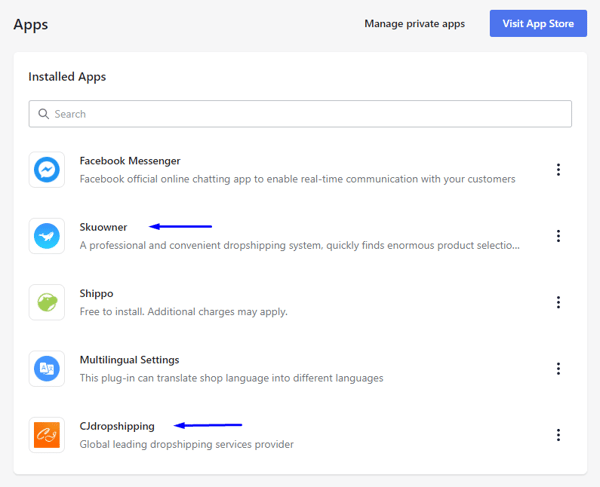
You can also work with different dropshipping apps simultaneously to increase the product offerings in your dropshipping store. In the example above, you can see that we’re using both Skuowner and CJDropshipping.
3. Pick your dropshipping suppliers
After downloading the dropshipping apps, you’ll need to sync your Shoplazza account with a merchant account created inside the dropshipping app. The process varies depending on the app, but it’s overall a pretty straightforward process.
If you run into any difficulties, we suggest checking out our dedicated Help Center articles:
As you start browsing product pages to pick out the items you want to import to your dropshipping store, pay special attention to the suppliers and sellers that you might run into.
How to find dropshipping suppliers?
To pick out a good and reliable dropshipping supplier, we recommend you keep an eye out for the following clues:
- Overall ratings: Hover your mouse over the name of the supplier to check some specific information about that business. On AliExpress, for instance, you’ll be able to see their business information, when they started working on the marketplace, how many followers they have and their ratings. Remember that, on AliExpress, a supplier can earn up to five stars. This means that the supplier below is a good pick, since their average rating is 4.8.

- Special badges: Some suppliers earn special badges like the “Top Brand” you see in AliExpress, which means that they are either top-rated stores or are an authorized reseller of a specific brand. The prices they offer might be a little higher than average, but it’ll help you ensure good quality and reliable services.
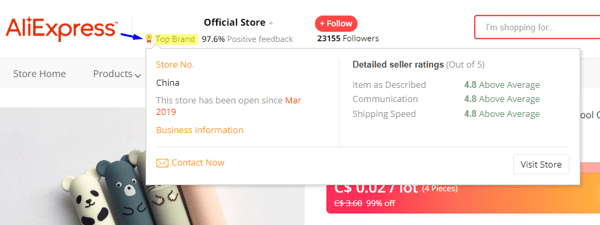
Once you’ve selected some reliable suppliers for your store, try reaching out to them via email. If you’re using AliExpress, simply click on the Contact Now option shown at the bottom of the image above.
Also, remember that it’s okay to work with multiple suppliers at the same time.
Important tip for entrepreneurs who want to learn how to dropship: Visit the supplier’s store
Before you close the deal with a supplier for your dropshipping store, be sure to visit their official page inside AliExpress. There, you’ll find more detailed info about their ratings, as well as their feedback history.
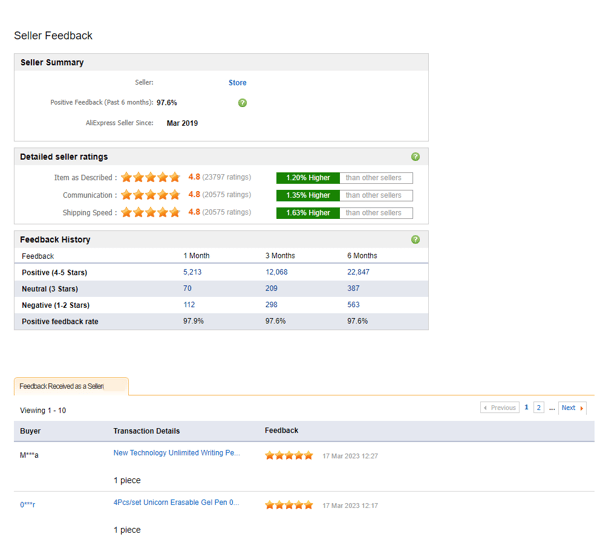
Shoplazza’s dropshipping guide: Feedback section of a supplier’s official page on AliExpress, with complete details about the feedback they received. Their ratings are also being compared with other sellers’, which is great data to have for making an informed decision.
4. Import products to your store
The next step of our dropshipping guide includes selecting a product that you wish to sell online in your own store.
This process can vary slightly depending on the dropshipping companies and apps you’re using within Shoplazza’s ecommerce platform, but it shouldn’t take more than a couple of clicks.
In the video below, we’re using CJDropshipping as an example. All you have to do is go to your admin and then either click on the pop-up Import Products or go to Apps in the left-hand menu to pick the app you’ll use.
This step is also the time to select the variants and sizes you wish to sell, evaluate the wholesale price the supplier is offering and then decide the price you’ll charge for each item, too. We’ll discuss this last one further down.
5. Edit the product page
After the product is successfully imported to your website, it’s time to edit the product page to make it appealing for customers.
Ideally, this page should contain great product photos and very detailed and enticing product descriptions. These descriptions should also undergo some sort of search engine optimization, or SEO, to up the chances of them being displayed organically in search results.
This is an important step in any guide on how to dropship. Images and descriptions from the supplier are imported by default to the admin, and while it might be good to have some photos already at hand, you should definitely craft your very own product descriptions. This will strengthen your branding and show customers what kind of personality your store has.
6. Set up prices and shipping costs
An important aspect for online stores that are reading through a dropshipping guide like this one is pricing: How to decide on a price for your products?
On the one hand, your price can’t be too high nor too low―if it’s too expensive, it might scare customers off, and if it’s too low, those same customers might get suspicious and think the store can’t be trusted.
On the other hand, you also need to consider your profit margins and your business strategy overall, which includes spending money on marketing strategies, paid traffic solutions and other campaigns to promote your ecommerce store.
As we mentioned earlier, you can set a preferred price before importing a product to Shoplazza. However, if you decide to change that pricing later or just edit it properly after running some calculations, all you have to do is head to your Shoplazza admin.
In the admin, go to Products in the left-hand menu and then navigate to the product you wish to edit. After you find it, click on Edit.
You’ll be redirected to the product page that we just saw in the step above. All you have to do is scroll down to the pricing menu and edit the value in Price (CAD):
How shipping works in the dropshipping supply chain
Shipping is another important aspect of learning how to dropship with an online store.
As we mentioned above, dropshipping is by default a business model in which the supplier is responsible for shipping the products to your end customer. This means that you, as the store owner, are not responsible for manually processing and shipping the items.
You are, however, still responsible not just for figuring out how much your customers will need to pay for shipping, but for deciding which shipping alternatives you’ll offer, too.
To set this up, you need to head to Settings > Shipping. Shoplazza works with shipping profiles, which gives you two main options:
- Set up a general shipping profile. This is the preferred alternative for online stores who want to offer the same shipping rates for all of their products.
- Create additional, customized shipping profiles to offer different shipping alternatives for specific products.
It’s also worth noting that a custom shipping profile can be a great solution for entrepreneurs who are setting up a diverse supply chain and thus have suppliers located in different countries.
In the video below, we show you how to create a general shipping profile:
👉🏽 A tip from Shoplazza’s dropshipping guide
To learn more about shipping costs, check out the video below:
Don’t forget the sales tax
Dropshipping businesses also need to set up a sales tax, which refers to a specific amount collected by your local government.
While the tax you’ll need to pay might vary according to (i) the type of product your store is selling and (ii) which country you’re shipping those products to, it’s important to keep in mind that all of your tax information will be stored under Settings > Taxes.
There, you’ll be able to create and edit two different types of taxes profiles:
- Base tax profile: This is the profile that will reflect your store’s more general tax information, and it will likely be the one you use the most. It’ll be applied to probably all or most of your products.
- Tax override profile: This is a profile intended for stores that sell to specific countries or regions that offer tax exemption to some of the products being sold online.
Important: To create your sales tax and your store’s tax profile, you first need to to fill out your shipping profile.

7. Select payment channels
Before you publish your new product pages, make sure that all your payment channels are set up so that customers are able to successfully checkout.
Currently, Shoplazza integrates with reliable payment solutions, like PayPal, Klarna, Stripe and Oceanpayment. To activate them in your store, simply go to Settings > Payments.
There, you’ll be able to select some recommended providers and confirm which ones are already set up (they’ll display an “Active” badge, like the one you see below). If you wish to search for other providers, simply click on Add payment provider.
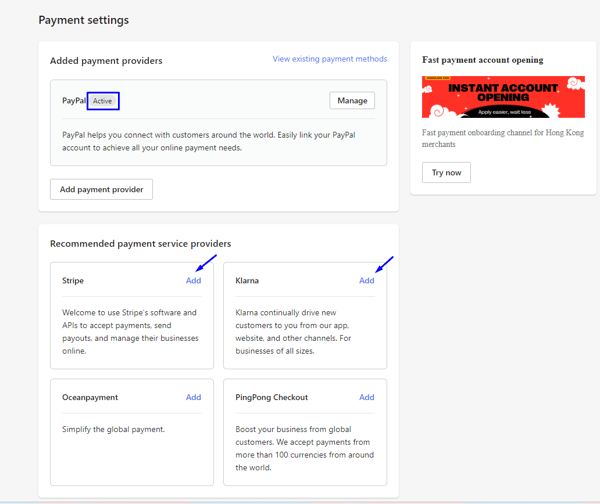
👉🏾 A tip from Shoplazza’s dropshipping guide
Interested in selling products with a Shoplazza store? Check out the video below for more information on the payment solutions you’ll be able to offer your customers.
8. Define checkout rules
One of the last aspects to cover on this dropshipping guide are the checkout rules, which dictate the conditions for customers and visitors alike to checkout in your online store.
To set those up, go to Settings > Checkout. There, you’ll be able to set up some crucial details for your store’s daily operations. For instance:
- Login request: Decide whether customers can checkout without an account within your store or if they need to register to do so.
- Inventory verification: This option relates to order fulfillment and inventory management. Will you allow customers to place orders even if a product is removed from the shelves? Or will they have to resubmit their orders if during the checkout process the item they want has gone out of stock?
- Checkout page: Will you offer a one-page checkout or a more extensive, two-page option?
- Automatic order cancellation: Set the amount of time after which an order with pending payment should be automatically canceled.
- Form options: Define the shipping information customers are required to enter at checkout.
- Taxpayer Identification Number: You can indicate the country and the necessary documents the customer needs to provide for tax declaration, customs or shipping requirements.
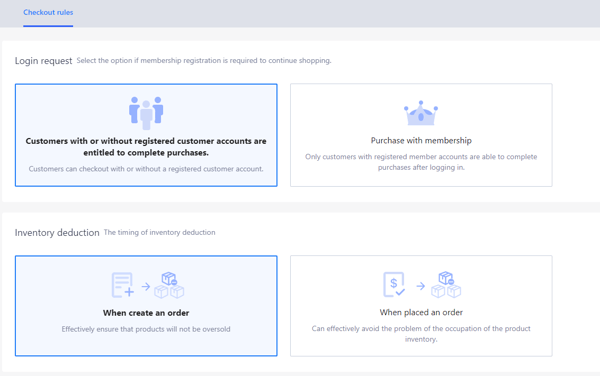
Store owners who are learning how to dropship with Shoplazza can easily adjust important checkout rules with the click of a button in their store’s admin.
9. Don’t neglect the order fulfillment tab
After the orders start to come in, keep an eye out for the purchase inventory of your store, which can be monitored directly under the Orders tab of the admin. There, you’ll be able to track important information that relates to your store’s order fulfillment activities, such as:
- Disputes: This is where you can track, resolve and respond to a dispute concerning an order.
- Unfulfilled: This view shows orders that have been processed through the store but haven’t been fulfilled yet.
- Abandoned checkouts: This is where you can check shopping carts that have been abandoned by visitors and customers. You can track the ones that are recoverable, too, and establish a marketing approach to make that happen.
Important tip: Test your products
Our dropshipping guide comes with what’s possibly our most valuable advice: Always test products before selling them on your store.
Whether it’s clothing, slippers, wireless headsets, mugs, jewelry, perfume or cameras, it’s crucial to assess not just the quality of those products but the dropshipping services provided by your supplier as a whole.
Consider placing some test orders to check the shipping timeframes your supplier is offering, the quality of the package when it’s delivered, and of course, what the product actually is like.
Dropshipping guide: How to market a dropshipping business
Apart from getting your store all set up, you should also start sketching out your marketing strategy to boost traffic and create more chances for future sales.
To put your dropshipping products out in the world, you can count on social media, paid marketing campaigns and, of course, SEO.
Social media
Instagram, TikTok and YouTube are all excellent channels to explore, especially if you want to sell products to a wider audience.
They are also a great place to create content about your products and your store as a whole, because you’ll be able to work with a variety of different formats and test out what works best for your audience.
👉🏿 A tip from Shoplazza’s dropshipping guide
Check out the video below to see how you can make the most of going live on TikTok:
Paid marketing
While it’s true that you need to have a more stable profit margin to consider comprehensive paid marketing strategies, there are plenty of things you can do with a restricted budget.
Consider paid Instagram ads, for instance―you can set up how much you’re willing to pay and decide on a fixed total budget for that. You’ll encounter a similar situation when advertising on YouTube.
Google Ads is also a great route to consider because it allows you to set up a budget (the amount you’ll pay for a specific campaign) and specific bidding options (which determine where your ad will be displayed within Google).
👉🏼 A tip from Shoplazza’s dropshipping guide
To create amazing Google Ads campaigns for your online store, check out the video below:
SEO
SEO is an important ally to any entrepreneur who wants to learn more about how to dropship, because it’s unquestionably one of the most robust strategies to get your brand in front of potential customers.
When done right, SEO should encompass all of your store’s content: from your blog to product descriptions, Instagram hashtags, the About Us page of the website and so much more.
Build a successful dropshipping business with Shoplazza
Unlike other business models, dropshipping can be a reliable avenue for first-time entrepreneurs who want to achieve sustainable profit margins without having to invest too much before getting started.
Because it’s a business model where the supplier is in charge of inventory management, dropshipping allows for an easy and quick start. All you have to do is join Shoplazza, connect with a dropshipping app and start importing products to your store.




